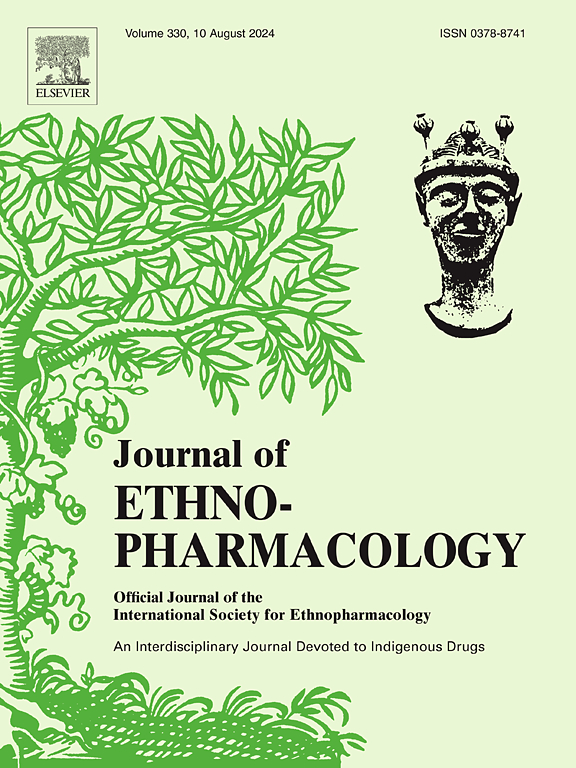Antiviral activity of HuaganJiedu decoction (HGJDD) against hepatitis B virus (HBV) through FOXO4/ERK/HNF4α signal pathway
IF 5.4
2区 医学
Q1 CHEMISTRY, MEDICINAL
引用次数: 0
Abstract
Ethnopharmacological relevance
Chronic hepatitis B virus (HBV) infection is still a widespread global health issue. HuaganJiedu Decoction (HGJDD) is a common prescription for treating HBV in China, which has the effect of enhancing antiviral efficacy and improving clinical efficacy. However, its precise mechanism of action remains unclear, warranting further investigation to elucidate its therapeutic potential and integration into standard medical practices.
Aim of the study
This study aims to explore the therapeutic mechanism of HuaganJiedu Decoction (HGJDD) in HBV.
Materials and methods
We investigated the therapeutic potential of HGJDD, and LC-MS analysis characterized the chemical profile of HGJDD. In vitro, we utilized HepG2.2.15 cell line to assess cytotoxicity and treatment efficacy of HGJDD compared to Entecavir controls. In vivo, assessments included monitoring HBV-related biomarkers and viral load. Network pharmacology and RNA-seq analyses identified molecular pathways and targets influenced by HGJDD treatment. Immunofluorescence and Western blotting provided further insights into the therapeutic mechanisms underlying HGJDD for HBV.
Results
HGJDD showed no toxicity on HepG2.2.15 cells at 10%, 20%, 40%, and 80% serum concentrations. In vitro, HGJDD reduced HBsAg, HBeAg, and HBV DNA levels by dose-dependently and time-dependently. HGJDD can decrease the levels of HBsAg, HBeAg, and HBV DNA in serum and liver levels, meanwhile the therapeutic effect of high-dose HGJDD approach to EVT’s in HBV Tg mice. According to intersection of network pharmacology and transcriptome, FOXO signal pathway was highlighted as potential targets and Immunofluorescence find that FOXO4D protein expression lever was increased in three HGJDD group, especially in high-dose HGJDD group. Western blotting confirmed increased level of FOXO4, ERK, and p-ERK and decreased levels of HNF4α, which reflected that the therapeutic effect was closely to FOXO4/ERK/HNF4α signal pathway.
Conclusions
Traditional Chinese medicine (TCM) offers diverse herbal treatments for HBV, with HGJDD showing efficacy in reducing HBsAg, HBeAg, and HBV DNA levels at cellular and animal levels. This study identified that FOXO4/ERK/HNF4α signal pathway played an important role in HGJDD’s therapeutic effects. These findings support HGJDD’s potential in HBV treatment, providing a scientific basis for clinical use.

花肝解毒汤(HGJDD)通过FOXO4/ERK/HNF4α信号通路对乙型肝炎病毒(HBV)的抗病毒活性
民族药理学相关性:慢性乙型肝炎病毒(HBV)感染仍然是一个广泛的全球健康问题。化肝解毒汤(HGJDD)是国内治疗HBV的常用方剂,具有增强抗病毒疗效,提高临床疗效的作用。然而,其确切的作用机制尚不清楚,需要进一步研究以阐明其治疗潜力并将其纳入标准医疗实践。研究目的:探讨化肝解毒汤(HGJDD)治疗HBV的作用机制。材料和方法:我们研究了HGJDD的治疗潜力,并通过LC-MS分析表征了HGJDD的化学特征。在体外,我们利用HepG2.2.15细胞系来评估HGJDD与恩替卡韦对照的细胞毒性和治疗效果。在体内,评估包括监测hbv相关生物标志物和病毒载量。网络药理学和RNA-seq分析确定了受HGJDD治疗影响的分子途径和靶点。免疫荧光和Western blotting进一步揭示了HGJDD治疗HBV的机制。结果:HGJDD在10%、20%、40%、80%血清浓度下对HepG2.2.15细胞无毒性作用。在体外,HGJDD降低HBsAg、HBeAg和HBV DNA水平呈剂量依赖性和时间依赖性。HGJDD可降低血清和肝脏中HBsAg、HBeAg、HBV DNA水平,同时观察大剂量HGJDD对HBV Tg小鼠EVT的治疗作用。通过网络药理学和转录组交叉分析,FOXO信号通路作为潜在靶点被突出,免疫荧光发现FOXO4D蛋白表达水平在三个HGJDD组中升高,特别是在高剂量HGJDD组。Western blotting证实FOXO4、ERK、p-ERK水平升高,HNF4α水平降低,提示治疗效果与FOXO4/ERK/HNF4α信号通路密切相关。结论:中药为HBV提供了多种草药治疗方法,HGJDD在细胞和动物水平上显示出降低HBsAg、HBeAg和HBV DNA水平的疗效。本研究发现FOXO4/ERK/HNF4α信号通路在HGJDD的治疗效果中发挥重要作用。这些发现支持了HGJDD治疗HBV的潜力,为临床应用提供了科学依据。
本文章由计算机程序翻译,如有差异,请以英文原文为准。
求助全文
约1分钟内获得全文
求助全文
来源期刊

Journal of ethnopharmacology
医学-全科医学与补充医学
CiteScore
10.30
自引率
5.60%
发文量
967
审稿时长
77 days
期刊介绍:
The Journal of Ethnopharmacology is dedicated to the exchange of information and understandings about people''s use of plants, fungi, animals, microorganisms and minerals and their biological and pharmacological effects based on the principles established through international conventions. Early people confronted with illness and disease, discovered a wealth of useful therapeutic agents in the plant and animal kingdoms. The empirical knowledge of these medicinal substances and their toxic potential was passed on by oral tradition and sometimes recorded in herbals and other texts on materia medica. Many valuable drugs of today (e.g., atropine, ephedrine, tubocurarine, digoxin, reserpine) came into use through the study of indigenous remedies. Chemists continue to use plant-derived drugs (e.g., morphine, taxol, physostigmine, quinidine, emetine) as prototypes in their attempts to develop more effective and less toxic medicinals.
 求助内容:
求助内容: 应助结果提醒方式:
应助结果提醒方式:


